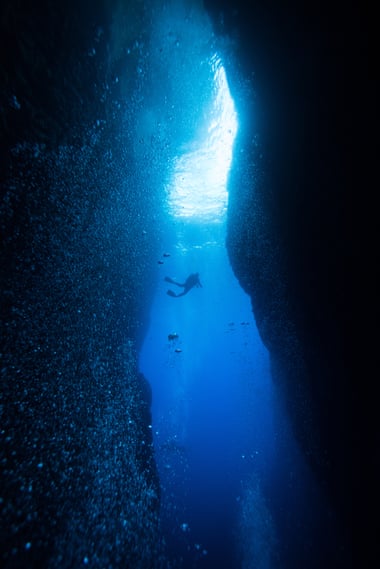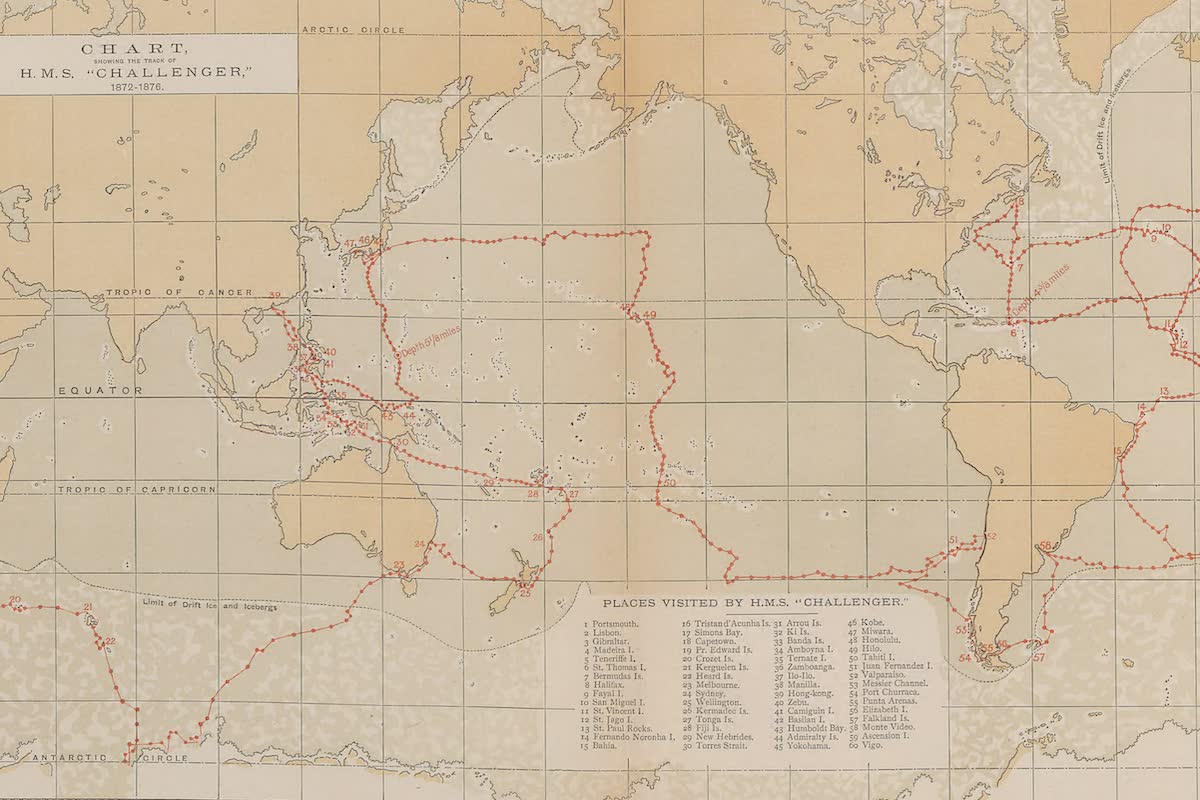Trace of the HMS Challenger 1872-1876
source History archive
From The Guardian by Robin Mckie
A century and a half after the Challenger mission transformed our understanding of the seas, researchers meet to tackle the latest threats
In a few days, several hundred researchers will gather in the UK to debate the crises facing the oceans – and to pay tribute to the expedition that first opened them up to scientific scrutiny.
Exactly 150 years ago, the Challenger expedition began a transformation in our understanding of the seas.
It revealed the existence of myriad forms of life at every depth and showed the ocean floor was not a featureless plain, as then thought, but was peppered with mountain ranges and deep trenches.
“We now know that the oceans play a fundamental role in driving Earth’s chemical, physical and biological processes,” said Nick Owens, director of the Scottish Association for Marine Science.
“They are crucial to the health of the planet and they are suffering from multiple threats today.
Challenger began that understanding, and it is appropriate that we mark the expedition’s 150th anniversary by comparing the state of the oceans then and now.”
When Challenger set sail, the seas were hardly affected by global warming; acidification caused by the absorption of carbon dioxide was not a problem; and the millions of tonnes of plastic that now pollute our seas remained a distant threat.
“The picture of the oceans that was revealed by Challenger provides us with a perfect baseline for looking at the state of our seas today,” said Owens, who will speak at the Challenger 150 conference which opens in London on 6 September.
Challenger sailed from Sheerness in December 1872 with a company of 250 sailors, engineers and marines – plus six scientists led by the Scottish naturalist Sir Charles Wyville Thomson.
Over the next four years, the vessel, which was fitted with a steam engine for dredging, sailed 68,890 nautical miles across the Pacific, Atlantic and Southern oceans; took 133 scoops from the ocean floor; carried out 492 deep-sea soundings and made 263 serial water temperature observations along its route.

The scientists and backers of the original Challenger deep sea expedition.
Photograph: Artokoloro/Alamy
Photograph: Artokoloro/Alamy
Apart from measuring sea depths, temperatures and currents, the expedition collected marine life from every part of the ocean.
More than 100,000 species were collected, preserved and returned to the expedition’s headquarters in Edinburgh.
It took a further 20 years to study these specimens, among which more than 4,700 new species of plants and sea life were discovered.
The final report, completed by John Murray after Thomson’s death in 1882, ran to 50 volumes.
“It was an extraordinary achievement,” said the marine researcher Adrian Glover of the Natural History Museum, one of the hosts of the Challenger 150 conference.
“Essentially, the Challenger expedition was the first multidisciplinary international science project.
“Until then, science tended to be carried out by individuals working in small laboratories.
Challenger changed that.
It tackled geology, chemistry, biology and a host of other disciplines.
It led to the birth of international interdisciplinary projects that now form the mainstay of research into topics such as climate change.”
At the time, most scientists thought the deep ocean floor was utterly uniform: a vast, flat expanse, filled with soft mud, said Erika Jones, curator of navigation and oceanography at the National Maritime Museum, Greenwich.
“Challenger showed this was definitely not the case.
It came back with these amazing charts that showed mountain ranges, valleys and vast trenches deep below the waves.”
The deepest of these is now known as the Challenger Deep.
It lies 10,900 metres below the surface in the western Pacific Ocean and is the deepest-known point on the surface of the Earth.
It was also thought that the deep ocean could not support life because it was too dark and too cold, and pressures were far too great.
Challenger changed that view as well, added Jones, whose book, The Challenger Expedition: Exploring the Ocean’s Depths ,will be published in October.
The species discovered by Challenger ranged from tiny shellfish to strange fish like the stargazing seadevil, Ceratias uranoscopus.
However, the Challenger discovery that may have the greatest impact in coming years looked undramatic at the time.
Dredging the Pacific seabed, the expedition brought up small nuggets of dark material covered with faint indentations.
“These were polymetallic nodules, and we now know they litter the seabed in their trillions,” said Glover.
The first nodule found by Challenger is on display in the Natural History Museum, he added.
These nodules are rich in manganese, nickel, cobalt and copper – used for making the electric cars, wind turbines and solar panels that are needed to replace the carbon-emitting lorries, power plants and factories wrecking our climate.
Mining companies say their extraction should be an international priority.
By dredging up nodules from the deep, we could help to halt the scorching of our planet’s ravaged surface, they argue.
Many marine scientists disagree.
“It is hard to imagine how seabed mines could feasibly operate without devastating species and ecosystems,” says UK marine biologist Helen Scales – a view shared by David Attenborough, who has called for a moratorium on all deep-sea mining plans.
It lies 10,900 metres below the surface in the western Pacific Ocean and is the deepest-known point on the surface of the Earth.
It was also thought that the deep ocean could not support life because it was too dark and too cold, and pressures were far too great.
Challenger changed that view as well, added Jones, whose book, The Challenger Expedition: Exploring the Ocean’s Depths ,will be published in October.
The species discovered by Challenger ranged from tiny shellfish to strange fish like the stargazing seadevil, Ceratias uranoscopus.
However, the Challenger discovery that may have the greatest impact in coming years looked undramatic at the time.
Dredging the Pacific seabed, the expedition brought up small nuggets of dark material covered with faint indentations.
“These were polymetallic nodules, and we now know they litter the seabed in their trillions,” said Glover.
The first nodule found by Challenger is on display in the Natural History Museum, he added.
These nodules are rich in manganese, nickel, cobalt and copper – used for making the electric cars, wind turbines and solar panels that are needed to replace the carbon-emitting lorries, power plants and factories wrecking our climate.
Mining companies say their extraction should be an international priority.
By dredging up nodules from the deep, we could help to halt the scorching of our planet’s ravaged surface, they argue.
Many marine scientists disagree.
“It is hard to imagine how seabed mines could feasibly operate without devastating species and ecosystems,” says UK marine biologist Helen Scales – a view shared by David Attenborough, who has called for a moratorium on all deep-sea mining plans.

The deep oceans were revealed by the Challenger expedition.
Photograph: Hoiseung Jung/Getty Images/EyeEm
Along with overfishing and climate change, the issue will be debated at the conference.
Mining companies say it should be relatively straightforward to suck up the nodules that litter the seabed.
Many marine biologists disagree.
The impact could be catastrophic, they say, though they acknowledge that this message can be difficult to get across.
“What is scary from a scientific point of view is that it is so difficult to demonstrate to the public how important these environments are for the health of the planet in terms of global nutrient cycling, carbon capture, and maintaining biodiversity,” said another keynote speaker, the marine chemist Katherine Duncan, of Strathclyde University.
“Images of the destruction of rainforests have a visceral impact but those of the ocean floor do not have that effect. A sponge is not as photogenic as an orang-utan.”
Yet the seabed has a lot to offer humanity, Duncan insisted.Right now UN delegates are deciding the fate of the largest habitat on Earth. Today is the last day of the last negotiation to protect biodiversity on the high seas. So let me show you all we can save... [a thread 🧵]#bbnj #icg5 #highseas pic.twitter.com/uiZ0xkuP2j
— Open Ocean Exploration (@RebeccaRHelm) August 26, 2022
Her research involves a process known as pattern-based genome mining which she has used to study sediment cores extracted from the ocean floor 4,000 metres deep off the coast of Antarctica.
This work has already revealed the existence of two new species of marine bacteria, Pseudonocardia abyssalis and Pseudonocardia oceani, which make antimicrobial compounds and could one day be used to make new ranges of antibiotics.
Although a relatively new science, research on marine organisms has already created dozens of effective drugs.
Examples include the sea squirt Ecteinascidia turbinata which attaches itself to mangrove roots: it was found to have anticancer properties and led to the development of Yondelis, a sarcoma and ovarian cancer drug.
Similarly, an extract from the sea snail, Conus magus, has been used in synthetic form to create Prialt, a chronic pain drug.
Corals, sea slugs, marine worms and molluscs have also been used to create promising medicines.
“The worry is that if we begin deep-sea mining without proper controls, we run the risk of destroying invaluable sources of medicines for the future,” added Duncan.
Other threats to the health of the oceans include overfishing.
More than 150 million tonnes of fish are caught for human consumption every year, and it is now estimated that a third of the planet’s fish stocks are being exploited unsustainably.
However, it is climate change that is the ultimate threat, Owens said.
“The oceans drive so many planetary processes and they are also absorbing most of the heat generated by our fossil fuel emissions.
In the end, there is only so much they can take, and from what we have learned about impacts over the past 150 years, it is clear they cannot take much more without there being significant impacts on the planet.”
Links :

No comments:
Post a Comment